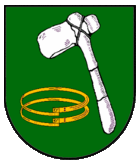Grave field in Deependahl
Coordinates: 53 ° 14 ′ 15.3 " N , 9 ° 4 ′ 1.5" E
| Grave field in Deependahl | ||
|---|---|---|
| location | Lower Saxony , Germany | |
| Location | Tarmstedt | |
|
|
||
| When | Neolithic | |
| Where |
Tarmstedt , Elbe-Weser triangle / Lower Saxony |
|
The burial ground in Deependahl von Tarmstedt in the Rotenburg (Wümme) district is located in Lower Saxony in the Elbe-Weser triangle , on the Geestrand of a meltwater valley. Let the relatively dense prehistoric settlement mounds fields , urn discoveries and settlements of the Roman Empire close.
In the middle of the 20th century, the hill burial ground "Im Deependahl" was almost completely destroyed by gravel mining . In 1966 several barrows could be examined, one of which showed findings in the form of a palisade , two tree coffin burials and a funeral hut (in older literature still referred to as the house of the dead).
The hill
Compared to other facilities of the burial ground, this barrow was relatively small with a residual height of 0.65 m and a diameter of 11.50 m. The hill was made of heather sods set up and from a Ortsteinband subjected which indicates that the area was overgrown with Heath before construction of the hill.
The stockade moat
A ditch about 0.4 meters wide, interrupted in the east, surrounded the round hill. The discoloration of the soil shows that the 15 to 20 cm thick posts were placed in the trench in a double row. They reached up to 60 cm in the "natural soil". Outside the palisade ring, the hill was surrounded by a layer of field stones about the size of a head.
The tree coffin
The central burial without gifts consisted of a tree coffin placed on the natural ground and surrounded by supporting stones, of which only remains were preserved.
The hut of the dead
The deliberate interruption of the moat consisted of a hut for the dead . The trench swung out at the ends to form an opening two feet wide. The end posts of his palisade were particularly strong with a diameter of 20 to 25 cm. Within the interruption there was a rectangular stone setting, which at 2.50 m × 1.0 m corresponded to the usual packing dimensions under tree coffins . A layer of charred wooden planks lay between and outside the stone setting. The corners of the stone setting were marked asymmetrically by four post holes , the charred remains of the post stuck in the holes. These posts were 20 to 25 cm in diameter and extended up to 70 cm into the natural soil. There were hardly any indications for the roof construction. Presumably the complex was burned down after the funeral ceremonies were over.
Since all the findings point to a building over a tree coffin burial, the complex should correspond to the huts of the dead found in different cultures. Most of the huts for the dead found in northern Germany date from the Older Bronze Age . However, they are generally larger and have more studs. Only a dead hut excavated near Schutschur near Neu Darchau in the Lüchow-Dannenberg district allows a comparison with the Tarmstedt building. In both places it seems to be a relatively close conversion of a tree coffin.
Although nothing concrete can be said about the architecture in Tarmstedt, the plank findings are interesting. Apart from the death hut in Gödensdorf , Harburg district, where pieces of clay suggested wickerwork walls, there was no evidence of the wall structure anywhere.
literature
- Jürgen Deichmüller : A palisade hill with tree coffin burial in the house of the dead near Tarmstedt, Kr. Bremervörde. In: New excavations and research in Lower Saxony 4. 1969, pp. 48–49.
- Gerhard Körner: A house of the dead near Schutschur, Kr. Dannenberg. In: Lower Saxony 43.1938, p. 359.

